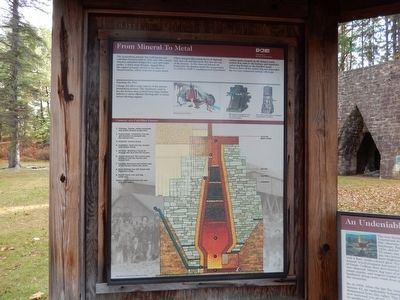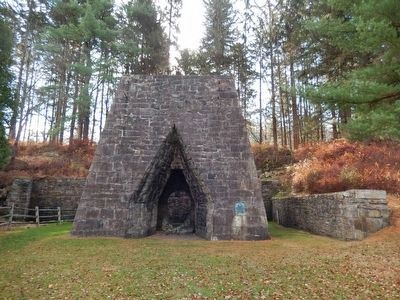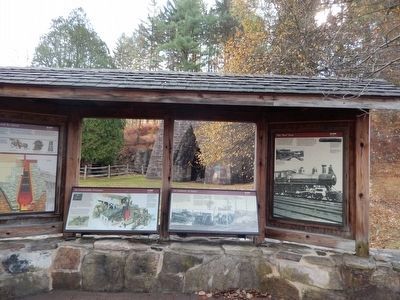From Mineral To Metal
Greenwood Furnace State Park
The ironmaking process was well-known and cold-blast furnaces built in 18th and 19th century America mimicked designs first used 400 years earlier. A thick stone furnace, shaped like a flat-topped pyramid, served as the place of transformation, where minerals became metal.
Fillers dumped alternating layers of charcoal fuel, iron ore and limestone flux into the top of the furnace. As the charcoal burned, air forced into the furnace raised the temperature to 2,600 to 3,000 F creating several byproducts.
Carbon gases escaped up the furnace stack, molten iron sank to the bottom, and impurities called slag floated on the liquefied metal. Workers drew off the useless slag and channeled the iron into connected castings called pigs.
Fanning the Fire
Change did affect some aspects of the ancient ironmaking process. The machinery used to fan the furnace fires evolved from huge leather bellows to more efficient blowing tubs to steam-driven blowing engines.
[Captions:]
Water-powered bellows
Blowing tubs pumped air into the furnace on both the up and down stroke
After 1850, steam engines sometimes powered blast machinery.
Cutaway of a Cold-Blast Furnace:
1. Chimney: Smoke, carbon monoxide and carbon dioxide escape here.
2. Tunnel Head: Limestone, iron ore, and charcoal are dumped into the furnace here.
3. Firebrick: Furnace lining.
4. Insulation: Sand and clay insulate and cushion lining.
5. Air Duct: Machinery forces air through this duct into the furnace. 6. Tuyere (twee-air): This narrow pipe directs air into the furnace and boosts heat.
7. Crucible: Narrowest and hottest part of the furnace where iron melts.
8. Bosh: Melting iron still mixed with impurities (slag).
9. Hearth Stone: Iron and slag settle here.
10. Dam Stone: Holds back iron and slag until tapped.
Erected by Pennsylvania Bureau of State Parks.
Topics. This historical marker is listed in this topic list: Industry & Commerce. A significant historical year for this entry is 1850.
Location. 40° 39.108′ N, 77° 45.205′ W. Marker is near Huntingdon, Pennsylvania, in Huntingdon County. It is in Jackson Township. Marker is on Broad Mountain Road. This marker is in Greenwood Furnace State Park. Touch for map. Marker is in this post office area: Huntingdon PA 16652, United States of America. Touch for directions.
Other nearby markers. At least 8 other markers are within walking distance of this marker. An Undeniable Presence (here, next to this marker); An Industry in Ruins (here, next to this marker); The “Best” Iron (here, next to this marker); Basic Ingredients (a few steps from this marker); The Worker’s Pyramid (a few steps from this marker); Greenwood Furnace (a few steps from this marker); Methodist Episcopal Church (about 400 feet away, measured in a direct line); Blacksmith & Wagon Shop (about 500 feet away). Touch for a list and map of all markers in Huntingdon.
Credits. This page was last revised on February 7, 2023. It was originally submitted on November 21, 2015, by Don Morfe of Baltimore, Maryland. This page has been viewed 237 times since then and 12 times this year. Photos: 1, 2, 3. submitted on November 21, 2015, by Don Morfe of Baltimore, Maryland. • Bill Pfingsten was the editor who published this page.


